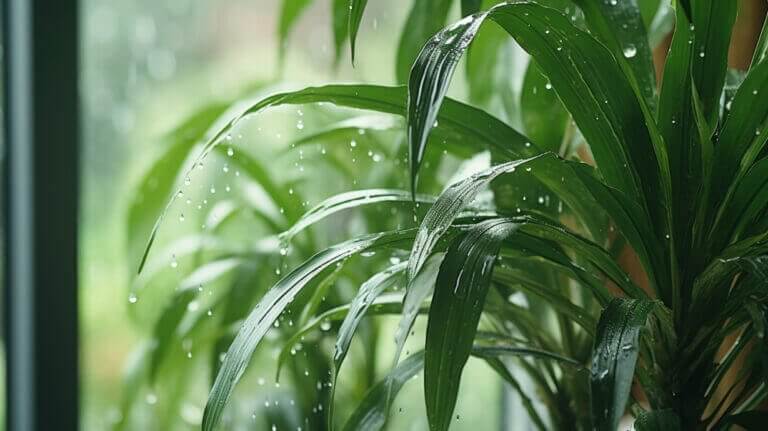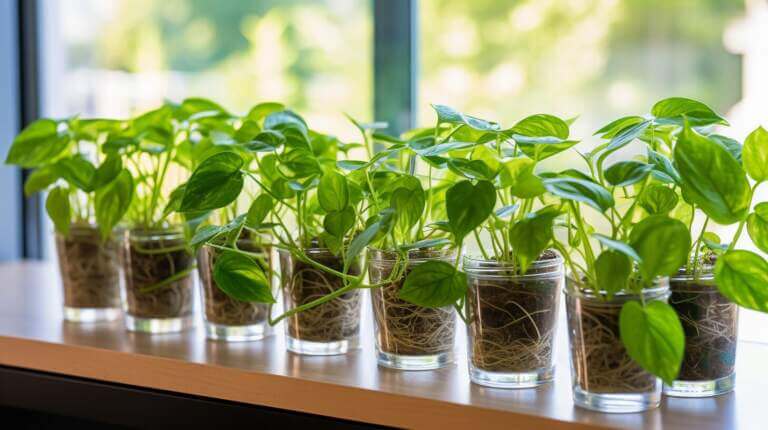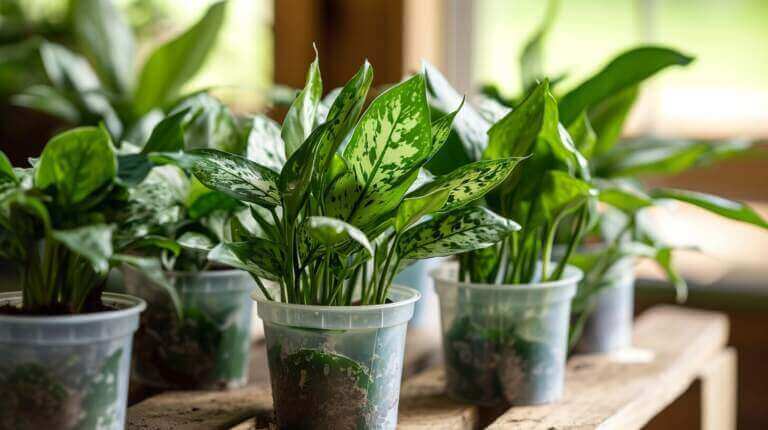Discover the hidden language of your Chinese Evergreen as we unravel the mystery behind its browning leaf tips. Like a secret code, these hints can reveal underlying environmental factors, watering habits, nutrient deficiencies, and even the presence of pests and diseases.
In this article, we will delve into the world of plant signals, equipping you with the knowledge to decode and address these issues. Get ready to become a plant detective and restore your Chinese Evergreen’s vibrant greenery.
Key Takeaways
- Chinese Evergreen plants are sensitive to changes in humidity levels and temperature fluctuations, which can cause brown tips on the leaves.
- Overwatering can result in brown tips, so it is important to use well-draining soil, water only when the soil is dry to the touch, and ensure proper drainage to avoid root rot.
- Nutrient deficiencies, such as nitrogen, phosphorus, and potassium, can also lead to brown tips on Chinese Evergreen leaves.
- Pests like spider mites, mealybugs, and scale insects, as well as diseases like root rot and leaf spot, can cause browning of leaf tips. Regular inspection and prompt action are necessary to prevent and address these issues.
Environmental Factors
One possible sentence for the subtopic of ‘Environmental Factors’ could be: ‘The tips of Chinese Evergreen leaves may turn brown due to various environmental factors.’
Chinese Evergreen plants are known for their ability to thrive in a variety of environments, but they are sensitive to changes in humidity levels and temperature fluctuations. High humidity levels can cause the leaves to develop brown tips, as the excess moisture can lead to fungal growth. On the other hand, low humidity levels can result in dry air that causes the leaf tips to become brown and crispy. Similarly, drastic temperature fluctuations can also contribute to browning leaf tips.
It is important to maintain stable humidity levels and provide a consistent temperature to prevent these environmental factors from affecting the health of your Chinese Evergreen.
Now let’s explore another common cause of browning leaves: overwatering.
Overwatering
Caused by excessive watering, the tips of Chinese Evergreen leaves can turn brown. Overwatering is a common issue that can be easily prevented by understanding the plant’s watering needs. Signs of overwatering include yellowing leaves, wilting, and root rot. To help you better understand how to prevent overwatering and recognize the signs, here is a table outlining key information:
| Preventing Overwatering | Signs of Overwatering |
|---|---|
| Use well-draining soil | Yellowing leaves |
| Water only when soil is dry to the touch | Wilting |
| Ensure proper drainage | Root rot |
Underwatering
Lack of sufficient watering, combined with environmental factors, can lead to the browning of the tips of Chinese Evergreen leaves. Indoor plants, such as the Chinese Evergreen, require proper watering techniques to thrive and maintain their vibrant green leaves.
Underwatering is a common issue that can cause the tips of the leaves to turn brown. When indoor plants do not receive enough water, their roots cannot absorb the necessary nutrients and moisture, leading to dehydration. As a result, the leaves may start to dry out and turn brown, particularly at the tips.
To prevent underwatering, it is important to establish a regular watering schedule for your Chinese Evergreen. Check the moisture level of the soil by sticking your finger about an inch into it. If it feels dry, it’s time to water the plant. Remember to water thoroughly, allowing the excess water to drain out of the pot. This will ensure that the roots receive the necessary hydration and nutrients to keep the leaves healthy and green.
In addition to proper watering, it is essential to consider environmental factors that may contribute to underwatering. For example, if your indoor plant is placed near a drafty window or heating vent, it may require more frequent watering due to increased evaporation. Adjusting the placement of your Chinese Evergreen can help maintain the moisture levels and prevent the tips from browning.
Nutrient Deficiency
To ensure the health and vitality of your Chinese Evergreen, it is important to address any nutrient deficiencies that may be causing the tips of the leaves to turn brown. Nutrient deficiencies can occur when the plant does not receive an adequate supply of essential minerals and elements.
These deficiencies can manifest as leaf discoloration, stunted growth, and overall poor plant health. To identify and correct nutrient deficiencies, it is helpful to understand the specific requirements of Chinese Evergreens. Here is a table outlining the essential nutrients needed for optimal plant care:
| Nutrient | Function | Signs of Deficiency |
|---|---|---|
| Nitrogen | Promotes leaf growth and green color | Yellowing leaves |
| Phosphorus | Supports root development and flower production | Poor flowering |
| Potassium | Aids in overall plant health and disease resistance | Leaf scorching |
Pests and Diseases
Unfortunately, pests and diseases can negatively impact the health of your Chinese Evergreen, leading to browning of the tips of the leaves. It is important to be aware of the common pests and diseases that can affect your plant so that you can take appropriate action to prevent or treat them.
Here are some of the common pests affecting Chinese evergreens:
- Spider mites: These tiny pests can cause discoloration and webbing on the leaves.
- Mealybugs: These white, cottony insects can feed on the sap of the plant and cause leaf yellowing and curling.
- Scale insects: These small, oval-shaped pests can attach themselves to the leaves and stems, sucking the plant’s sap.
In addition to pests, there are diseases that can affect Chinese evergreen plants:
- Root rot: Overwatering can lead to root rot, causing the plant’s roots to decay and the leaves to turn brown.
- Leaf spot: Fungal infections can cause dark, water-soaked spots on the leaves, which can eventually turn brown.
- Bacterial blight: This disease can cause browning and wilting of the leaves, along with stem rot.
Regularly inspecting your Chinese Evergreen for signs of pests or diseases and taking prompt action can help ensure the health and vitality of your plant.
Frequently Asked Questions
How Often Should I Fertilize My Chinese Evergreen Plant?
When it comes to fertilizing your Chinese Evergreen plant, it is important to find the right balance. Over-fertilization can lead to brown tips on the leaves.
As a general guideline, it is recommended to fertilize your plant every 2-4 weeks during the growing season (spring and summer) and reduce the frequency to once every 6-8 weeks during the dormant period (fall and winter).
Avoid common mistakes such as using too much fertilizer or not diluting it properly, as this can harm your plant.
Can Chinese Evergreen Plants Tolerate Low Light Conditions?
Chinese evergreen plants can tolerate low light conditions, making them a popular choice for indoor spaces with limited sunlight. To care for Chinese evergreen plants in low light, it is important to place them in a spot that receives indirect or filtered light. Avoid placing them in direct sunlight as it can scorch their leaves.
Additionally, ensure that the soil is well-draining and water the plant when the top inch of soil feels dry. Regularly dusting the leaves and providing occasional fertilization can also promote healthy growth in low light conditions.
Can I Trim the Brown Tips of My Chinese Evergreen Leaves to Improve Their Appearance?
To improve the appearance of Chinese Evergreen leaves, one may consider trimming the brown tips. Trimming the leaves can help to maintain a neat and healthy look for the plant.
However, it is important to identify the underlying cause of the browning tips to prevent further damage. Factors such as improper watering, low humidity, or inadequate lighting can contribute to this issue.
Addressing these factors will not only enhance the appearance but also promote the overall health of the Chinese Evergreen plant.
Are Brown Tips on Chinese Evergreen Leaves a Sign of Curling Leaves?
Repotting your Chinese Evergreen plant can indeed be beneficial in preventing the tips of the leaves from turning brown. By repotting, you provide fresh soil and nutrients to the plant, ensuring its overall health and vitality.
However, it is important to note that repotting alone may not completely solve the issue. Other factors, such as improper watering, low humidity, or inadequate lighting, can also cause browning of leaf tips. Therefore, it is advisable to consider alternative solutions, such as adjusting watering practices or providing adequate humidity and lighting conditions, in conjunction with repotting.
Are There Any Specific Temperature Requirements for Chinese Evergreen Plants That Could Cause Their Leaves to Brown?
Chinese evergreen plants have specific temperature requirements that can contribute to leaf discoloration, including browning of the tips. These plants prefer temperatures between 60-75 degrees Fahrenheit, with a minimum temperature of 50 degrees Fahrenheit.
Exposure to extreme cold or hot temperatures can cause stress to the plant, leading to leaf damage and browning. It is important to ensure that the plant is kept in a suitable temperature range to maintain healthy foliage and prevent leaf browning.







